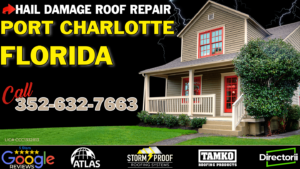Guarding Your Roof: Unveiling the Secrets of Hail Damage and Fortifying your Shelter
Introduction
Imagine a violent storm brewing above, with dark clouds swirling ominously and thunder rumbling in the distance. As rain pours down, suddenly, something unexpected begins to fall from the sky: hailstones. These ice projectiles, ranging in size from pea-sized pellets to massive chunks of ice, can wreak havoc on our homes and properties.
In particular, our roofs bear the brunt of hail’s fury. Understanding hail damage and taking preventive measures is crucial to safeguarding one of the most vital components of our dwellings.
Hail damage refers to the destruction caused by hailstones impacting a roof’s surface. As these icy missiles plummet from the sky with great force, they can inflict severe harm upon various roofing materials.
The impact often leads to dents, cracks, punctures, or even complete destruction of shingles or tiles. While it may seem like a singular event during a thunderstorm, hail damage can have lasting consequences for homeowners if left unaddressed.
The importance of understanding hail damage goes beyond mere awareness; it lies in proactively protecting our roofs against potential harm. Our roofs shield us from nature’s elements day in and day out – be it scorching sunrays or torrential rainfall – thus ensuring their integrity is paramount to maintaining a safe and secure living environment.
By comprehending how hail damage occurs and its potential impact on different roofing materials, we equip ourselves with knowledge that empowers us to take preventive measures before disaster strikes. Ultimately, learning about hail damage serves as an investment in safeguarding one’s property value and minimizing unnecessary repair costs down the line.
It also enables homeowners to make informed decisions when choosing roofing materials that are more resistant to hail impact or implementing protective measures such as installing impact-resistant barriers or reinforcing existing roofing structures. Therefore, let us delve into understanding the intricacies of hailstorms’ destructive power on our beloved roofs and discover ways we can fortify them against nature’s icy artillery.
Understanding Hail Damage
When it comes to protecting your roof from hail damage, knowledge is your first line of defense. Understanding how hail forms and the factors that determine the severity of hailstorms can help you better prepare and take appropriate preventive measures. Let’s delve into the fascinating world of hail.
The Formation of Hail
Hail is formed within thunderstorms when updrafts carry raindrops upward into extremely cold regions of the atmosphere. These supercooled water droplets freeze onto ice nuclei, creating small ice pellets.
As these pellets are caught in the cycle of being carried upward and then plummeting back down through layers of moisture, they accumulate additional layers of ice, forming hailstones. The size and density of hailstones play a crucial role in determining the potential damage they can cause to your roof.
Hailstones can vary greatly in size, ranging from tiny pebbles to golf ball-sized or even larger masses. The larger and denser the hailstone, the greater its impact force upon contact with your roof.
Factors Impacting Hailstorm Severity
Hailstorms vary in intensity based on different factors that influence their severity. Wind speed and direction during a storm have a considerable impact on how intense the accompanying hail will be. Strong updrafts within thunderstorms keep hail aloft for longer periods, allowing it to grow larger before finally descending towards Earth’s surface.
The angle at which hailstones strike your roof also influences the extent of damage they inflict. A steeper angle increases impact force because it reduces deflection and disperses less energy upon contact with your roof surface.
Types of Roofing Materials Susceptible to Hail Damage
Asphalt Shingles
Asphalt shingles are among the most popular roofing materials due to their affordability and versatility. They consist of a fiberglass or organic mat embedded in asphalt, topped with mineral granules for protection against the elements. However, these shingles are susceptible to hail damage due to their composition and structure.
Hailstones can cause significant impact damage to asphalt shingles. The force of hailstones hitting the roof can lead to cracks, dents, or even punctures in the shingle surface.
The vulnerability of asphalt shingles also depends on their age and quality. Older or worn-out shingles may be more prone to hail damage compared to newer ones with better durability.
After a hailstorm, it is crucial to inspect your asphalt shingle roof for signs of damage. Look for bruised or missing granules on the surface as they indicate areas where the protective layer has been compromised.
Check for cracks or splits in individual shingles, as well as dents caused by significant impacts from larger hailstones. Additionally, keep an eye out for any water leaks inside your home that may result from damaged shingles.
Metal Roofs
Metal roofs are known for their durability and longevity, making them an attractive choice for homeowners seeking protection against various weather conditions, including hailstorms. Different metal materials such as steel, aluminum, and copper offer varying degrees of resilience against hail impact.
Steel roofs are commonly used and provide excellent protection against moderate-sized hailstones due to their strength. Aluminum roofs are lightweight yet sturdy, making them less susceptible to denting from smaller hailstones; however, large-sized projectiles can still cause some damage.
Copper roofs possess exceptional resistance against all sizes of hailstones, thanks to the metal’s inherent strength and malleability. The ability of metal roofs to withstand hail damage also depends on their thickness and quality.
Thicker gauges of metal are generally more resistant to dents and punctures caused by hail. High-quality metal roofs often have protective coatings or paint finishes that enhance their durability against impacts, mitigating potential damage from hailstorms.
Clay or Concrete Tiles
Clay or concrete tiles are renowned for their aesthetic appeal and longevity. They provide excellent protection against smaller-sized hailstones due to their solid structure and weight.
However, larger hailstones can pose a threat to tile roofs as they are more vulnerable to impact damage compared to other materials. During a severe hailstorm, the forceful impact of larger hailstones can cause cracking or chipping in clay or concrete tiles.
These damages may not be immediately visible but can lead to long-term issues, such as water leaks or compromised structural integrity. It is crucial to inspect your tile roof after a hailstorm for any signs of damage.
If you notice cracked or chipped tiles on your roof, it is advisable to consult a professional roofer who specializes in tile repairs. They can assess the extent of the damage and recommend appropriate measures such as replacing damaged tiles or performing necessary repairs.
Assessing Hail Damage on Your Roof
A. Visual
Assessing hail damage on your roof visually is an essential step in determining the extent of the damage. Start by examining the shingles or tiles for any visible signs of impact, such as dents, cracks, or missing pieces.
Inspect the gutter system and downspouts for granules or small fragments that may have been dislodged during a storm. Keep in mind that some damage may not be immediately noticeable, especially with asphalt shingles, where granule loss may occur gradually over time after a hailstorm.
Take note of any irregular patterns or concentrated areas of damage as these could indicate the direction and intensity of the hailstones. Additionally, inspect your roof for any signs of leaks or water stains inside your home.
Hail damage can compromise the integrity of your roof and lead to water penetration during subsequent rainstorms. Look for water spots on ceilings or walls and check attic spaces for any signs of moisture, mold growth, or insulation damage.
Conclusion
Assessing hail damage on your roof is crucial to understand the potential risks it poses to your home’s structural integrity and overall protection from the elements. By visually examining your roof for visible signs of impact and investigating possible leaks or water stains inside your home, you can effectively determine if professional repair or replacement is necessary. While hailstorms can be destructive and cause significant property damage, it is important to remember that proper assessment followed by timely repairs can help safeguard your residence.
By addressing any issues promptly, you can restore peace of mind knowing that your roof will continue to provide reliable shelter for years to come. Remember that regular maintenance and inspections are key in preventing future problems caused by hailstorms.
Stay proactive in protecting your home against potential hazards by consulting with roofing professionals who can guide you through any necessary repairs or recommend preventive measures to fortify your roof against future hail damage. By taking these precautions, you can ensure the longevity and resilience of your roof, enhancing the safety and value of your home.



